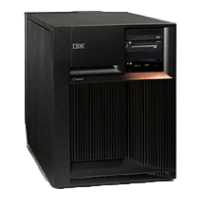v Yes: Go to step 6 (See page 566).
5. Working with the customer, use Hardware Service Manager (HSM) to switch ownership of the
tower’s switchable resources to the tower’s SPCN (Power) controlling system. To do this use the
Service Reference Procedures in the iSeries Service Functions
information.
Were you able to switch ownership of the tower’s switchable resources to the tower’s SPCN (Power)
controlling system?
v Yes: Continue with the next step.
v No: Contact your next level of support.
This ends the procedure.
6. Perform this procedure from the SPCN controlling system’s Primary partition until you are directed to
do otherwise.
Work with the customer to end the Cluster Resource Group (CRG) containing DASD units configured
as independent ASPs (IASP) under the tower’s HSL I/O bridge resource. Refer to the OptiConnect for
OS/400 information.
Were you able to end the CRG?
v No: Continue with the next step.
v Yes: Go to step 8 (See page 566).
7. Working with the customer, use Hardware Service Manager to switch the towers mode to ″Private″
using the Service Reference Procedures in the iSeries Service Functions
information.
Were you able to to switch the towers mode to ″Private″?
v Yes: Continue with the next step.
v No: Contact your next level of support.
This ends the procedure.
8. Check to see that no other towers controlled by this system’s SPCN are powered off at this time.
Perform Bus PIP HSL-05, then return here and continue with the next step of this procedure.
Attention: During this procedure only one tower connected to this system can be powered off. You
must not have more than one tower powered off at any given time during this service action.
9. Using the HSL loop configuration and status form, identify the tower that you are working on. Look at
the ″Link status″ of the other rows to see if there are any failed links, other than the links that you
recorded for the tower that you are working on.
Are there any other failed links that are not associated with the tower that you are working on?
v Yes: Continue with the next step.
v No: Go to step 11 (See page 566).
10.
On the form, look to see if there are any ″operational″ links between this tower and a failed link.
Are there any such ″operational″ links?
v No: Continue with the next step.
v Yes: You can not use this procedure to power off the tower. Doing so will cause resources to be
lost as well as a possible system failure. You must power down the system to continue working on
this tower. See Power on/off the system and logical partitions.
This
ends the procedure.
11. Examine table “HSL loop configuration and status form” on page 590, to determine if the tower that
you are working on is linked to an SPD migrated tower (FC 5033, 5034, 5035, or 5077).
Is an SPD migrated tower the next link (leading or trailing) from the tower that you are working on?
566 Hardware (Remove and Replace; Part Locations and Listings)
